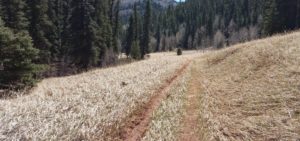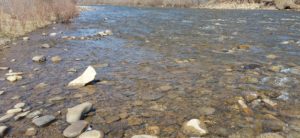Took a drive up to Lizard Head Pass last Saturday, April 21, and there was too much snow to hike the trail. Up there, in the San Miguels, I caught the north facing slopes, and there was much more snow than on the west-facing slopes of the La Platas, my home range, farther south near Mesa Verde. So, I drove south along the North Dolores Highway, and pulled in at Priest Gulch, in the foothills of the San Juans. From the trailhead on the way up for about an hour, the soil was dry, as you can see in the photo at the top of this post.
We are in epic drought, and haven’t had significant precip since late last summer. It’s been described as disastrous. There’s still some melt up there, high at Lizard Head, but take a look at the picture below.
It’s hard to know, but the percentage of snowpack is low compared to the historical baseline. The picture above was taken below Dutton, and my memory says it should be higher, compared to other years. Stock ponds are disappearing in a way that I’ve never seen. Pintails and Canada geese are leaving this impounded water, in search of wetter nesting sites. The grasses which almost always green this time of year are midsummer brown. The spring windstorms have been unusually fierce and prolonged, which has contributed to the desiccation, not only of the mountain snowpack, but of the lower foothills and lowland pastures as well. Precipitation that was predicted to accompany the windstorms blew right over the mountains.
I have a (bad) feeling that this coming fire season will be a seminal time here in the southwest. Hundreds of years past, the Ancestral Puebloans’ budding civilization was decimated. The main cause was most likely a catastrophic drought that hit agricultural production. Although archaeologists often debate the causes of the Anasazi decline, drought always comes up #1.
Now, reservoirs are low, and new buds on trees and other veg seem destined to wither. The whole time I hiked up Priest Gulch, I kicked up dust from the trail. The oak brush was dry and gray, like brittle shale. The earth tones starved of feminine greens. At home, only weeds sprouting.
If the monsoons are good, we may just be alright. The last couple years, seasonal patterns all seem to be a month late. But the year 2017-18 may become known as the year winter itself was a year late. Stay tuned.
Update: in 2022, the monsoons were much better here in the Four Corners. It’s the rest of the world that’s experiencing exceptional drought. From China to Europe to Mexico and North America, the phrase most often used is worst drought on record. Some climatologists are pointing to the heat-trapping effects of circumpolar gyres, or great atmospheric circulations.
© 2022 by Michael C. Just
Mike’s novel, The Dirt: The Journey of a Mystic Cowboy, is available in softcover or eBook formats through Amazon.
You can purchase the book through this website. Or go straight to amazon at https://www.amazon.com/s?k=the+dirt+journey+of+a+mystic+cowboy&crid=1S40Q4BXSUWJ6&sprefix=the+dirt%3A+journey+of+a+m%2Caps%2C180&ref=nb_sb_ss_i_1_23
Mike’s other titles, including The Crippy, The Mind Altar, and Canyon Calls, are available through this website or through Amazon at https://www.amazon.com/-/e/B002
Four of his short stories have recently been published online:
Lies, Ltd. has been published by The Mystery Tribune @ Lies, Ltd.: Literary Short Fiction by Michael C. Just (mysterytribune.com)
The Obligate Carnivore has been published by the Scarlet Leaf Review @ Category: MICHAEL JUST – SCARLET LEAF REVIEW
I See You, Too has been published by the 96th of October @ I See You, Too – 96th of October
Offload, a short story about a man who can heal any disease, is now live and can be read at The Worlds Within at Offload – The Worlds Within


